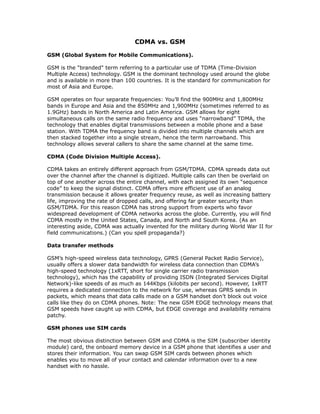
CDMA vs GSM: Comparing Mobile Network Technologies
- 1. CDMA vs. GSM GSM (Global System for Mobile Communications). GSM is the "branded" term referring to a particular use of TDMA (Time-Division Multiple Access) technology. GSM is the dominant technology used around the globe and is available in more than 100 countries. It is the standard for communication for most of Asia and Europe. GSM operates on four separate frequencies: You’ll find the 900MHz and 1,800MHz bands in Europe and Asia and the 850MHz and 1,900MHz (sometimes referred to as 1.9GHz) bands in North America and Latin America. GSM allows for eight simultaneous calls on the same radio frequency and uses “narrowband” TDMA, the technology that enables digital transmissions between a mobile phone and a base station. With TDMA the frequency band is divided into multiple channels which are then stacked together into a single stream, hence the term narrowband. This technology allows several callers to share the same channel at the same time. CDMA (Code Division Multiple Access). CDMA takes an entirely different approach from GSM/TDMA. CDMA spreads data out over the channel after the channel is digitized. Multiple calls can then be overlaid on top of one another across the entire channel, with each assigned its own “sequence code” to keep the signal distinct. CDMA offers more efficient use of an analog transmission because it allows greater frequency reuse, as well as increasing battery life, improving the rate of dropped calls, and offering far greater security than GSM/TDMA. For this reason CDMA has strong support from experts who favor widespread development of CDMA networks across the globe. Currently, you will find CDMA mostly in the United States, Canada, and North and South Korea. (As an interesting aside, CDMA was actually invented for the military during World War II for field communications.) (Can you spell propaganda?) Data transfer methods GSM’s high-speed wireless data technology, GPRS (General Packet Radio Service), usually offers a slower data bandwidth for wireless data connection than CDMA’s high-speed technology (1xRTT, short for single carrier radio transmission technology), which has the capability of providing ISDN (Integrated Services Digital Network)-like speeds of as much as 144Kbps (kilobits per second). However, 1xRTT requires a dedicated connection to the network for use, whereas GPRS sends in packets, which means that data calls made on a GSM handset don’t block out voice calls like they do on CDMA phones. Note: The new GSM EDGE technology means that GSM speeds have caught up with CDMA, but EDGE coverage and availability remains patchy. GSM phones use SIM cards The most obvious distinction between GSM and CDMA is the SIM (subscriber identity module) card, the onboard memory device in a GSM phone that identifies a user and stores their information. You can swap GSM SIM cards between phones which enables you to move all of your contact and calendar information over to a new handset with no hassle.
- 2. CDMA operators answer this flexibility with their own service that stores user data on the operator’s database. This service makes it possible to swap handsets with little trouble and also provides the ability to recover contact data even if their phone is lost or stolen. These services are usually available for GSM phones too, so it's not really an advantage of CDMA, more of a disadvantage is that they don't have SIM cards. DIFFERENCE BETWEEN GSM AND CDMA The major difference between GSM/TDMA and CDMA is in the way they divide up those signals between multiple users. GSM/TDMA uses a Time Division method. TDMA, in fact, stands for Time Division Multiple Access. Simply put, this means that each device on the local network is allocated a time slice where it "owns" the bandwidth, and it can send/receive its data. So lets just pick a number and say there are 30 available time slices in a given cycle. Each phone would then get 1/30th of every cycle that it could send and receive data (aka, voice). CDMA uses a different method, called Code Division Multiple Access. The specifics of how it breaks the cycle up are beyond me, but how it works out is that the phones only get a slice of the bandwidth cycle when they actually need one. So if you are not talking, and the other person is not talking, nothing is transmitted. With GSM/TDMA, each phone is transmitting and receiving during its slices of the bandwidth cycle, whether it needs it or not. Since most conversations are comprised largely of silence, the end result is that CDMA phones have to transmit less data. They don't have to send silence, like GSM/TDMA phones do. This means a few things. More CDMA calls can be fit into a given amount of frequency spectrum (ie. it is more efficient for the network), less radiation is being created from the phone towards the user (you only get radiation when you are talking, basically), and battery power is conserved since the handset only transmits when it actually has something to send. There are other differences, too, that I can't get into. For one, it is harder to implement a CDMA network. The tower placement is more difficult. Dealing with hills is more difficult than with GSM/TDMA. Things like that. But in general, CDMA is vastly superior technology. Not surprising since Qualcomm's version of it (that which is used in CDMA and WCDMA phones) is newer technology, even if the basics were in use by the US military as far back as the 40s. The important thing for me, though, is the SIM card. Had CDMA implemented the use of a SIM card (something it very easily could have done), then the North American market would be very different today, and there would be more CDMA networks in other countries. The SIM card allows people to easily switch phones, and that helps the market.
